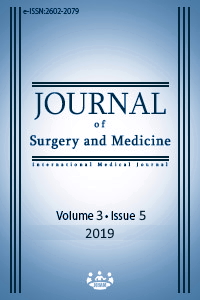Evaluation of preoperative neutrophil-lymphocyte ratio in differentiated thyroid carcinoma with lymph node metastasis
Keywords:
Neutrophil, Lymphocyte, Thyroid, CarcinomaAbstract
Aim: Systemic inflammatory response has been shown to play a critical role in all stages of tumor development, progression and metastasis. High neutrophil lymphocyte ratio (NLR) is thought to be an indicator of poor prognosis of tumors. In this study, we investigated the relationship between preoperative NLR and lymph node metastasis of differentiated thyroid carcinoma (DTC).
Methods: The study included a total of 74 patients diagnosed with DTC according to pathology results after thyroid surgery. The NLR was determined by dividing the absolute neutrophil count in the whole blood count by the lymphocyte count. Optimal cut-off value was estimated by means of ROC curve. The study was designed a cross-sectional study.
Results: With a 95% confidence interval, the area under the curve of 0.620 and the likelihood ratio of 3.2, the cut-off value for NLR was found to be 2.59 with 44.4% sensitivity and 86.2% specificity, respectively. There was a significant relationship between the current cut off value and the lymph node metastasis of DTC (P=0.03).
Conclusion: NLR was found to be significantly increased in lymph node-positive differentiated thyroid cancers. The neutrophil to lymphocyte ratio as an inflammation index is inexpensive for patients with differentiated thyroid carcinoma, easily available and easy to obtain from routine blood tests.
Downloads
References
Moore MM, Chua W, Charles KA, Clarke SJ. Inflammation and cancer: causes and consequences. Clinical Pharmacology and Therapeutics. 2010;87(4):504–8.
Çelen S, Günseren KÖ, Özlülerden Y, Mete A, Tuncay ÖL, Yavaşcaoğlu İ. Does neutrophil-lymphocyte ratio show recurrence in patients who underwent curative resection for non-muscle-invasive bladder cancer? J Surg Med. 2019;3(4):324-7.
Liu CL, Lee J, Liu T, Chang Y, Hsu Y-C, Cheng S-P. Blood neutrophil-to-lymphocyte ratio correlates with tumor size in patients with differentiated thyroid cancer. Journal of Surgical Oncology. 2013;107(5):493–7.
Guthrie GJ, Charles KA, Roxburgh CS, Horgan PG, McMillan DC, Clarke SJ. The systemic inflammation-based neutrophil-lymphocyte ratio: experience in patients with cancer. Crit Rev Oncol Hematol. 2013 Oct;88(1):218-30.
Unal D, Eroglu C, Kurtul N, Oguz A, Tasdemir A. Are neutrophil/lymphocyte and platelet/lymphocyte rates in patients with non-small cell lung cancer associated with treatment response and prognosis. Asian Pac J Cancer Prev. 2013;14(9):5237–42
Jin H, Zhang G, Liu X, Liu X, Chen C, Yu H, et al. Blood neutrophil-lymphocyte ratio predicts survival for stages III-IV gastric cancer treated with neoadjuvant chemotherapy. World J Surg Oncol. 2013;11:112.
Bhatti I, Peacock O, Lloyd G, Larvin M, Hall RI. Preoperative hematologic markers as independent predictors of prognosis in resected pancreatic ductal adenocarcinoma: neutrophil-lymphocyte versus platelet-lymphocyte ratio. Am J Surg. 2010;200(2):197–03.
Larson SD, Jackson LN, Riall TS, Uchida T, Thomas RP, Qiu S, et al. Increased incidence of well-differentiated thyroid cancer associated with Hashimoto thyroiditis and the role of the PI3k/Akt pathway. Journal of the American College of Surgeons. 2007;204(5):764–73.
Proctor MJ, McMillan DC, Morrison DS, Fletcher CD, Horgan PG, Clarke SJ. A derived neutrophil to lymphocyte ratio predicts survival in patients with cancer. British journal of cancer. 2012 Aug 7;107(4):695-9.
Clarke SJ, Chua W, Moore M, Kao S, Phan V, Tan C, et al. Use of inflammatory markers to guide cancer treatment. Clinical pharmacology and therapeutics. 2011 Sep;90(3):475-8.
Kim JY, Park T, Jeong SH, Jeong CY, Ju YT, Lee YJ, et al. Prognostic importance of baseline neutrophil to lymphocyte ratio in patients with advanced papillary thyroid carcinomas. Endocrine. 2014 Aug;46(3):526-31.
Liu J, Du J, Fan J, Liu K, Zhang B, Wang S, et al. The Neutrophil-to-Lymphocyte Ratio Correlates with Age in Patients with Papillary Thyroid Carcinoma. ORL J Otorhinolaryngol Relat Spec. 2015;77(2):109-16.
Edge SB, Byrd DR, Compton CC, Fritz AG, Greene FL, TroG A. Thyroid cancer staging. AJCC Cancer Staging Manual. 7th edition. Springer-Verlag, New York, 2010. p.59-64.
Kantola T, Klintrup K, Väyrynen JP, Vornanen J, Bloigu R, Karhu T, et al. Stage-dependent alterations of the serum cytokine pattern in colorectal carcinoma. Br J Cancer. 2012;107(10):1729–36.
Bausch D, Pausch T, Krauss T, Hopt UT, Fernandez-del-Castillo C, Warshaw AL, et al. Neutrophil granulocyte derived MMP-9 is a VEGF independent functional component of the angiogenic switch in pancreatic ductal adenocarcinoma. Angiogenesis. 2011;14(3):235–43.
Tecchio C, Cassatella MA. Neutrophil-derived cytokines involved in physiological and pathological angiogenesis. Chem Immunol Allergy. 2014;99:123–37.
Song MK, Chung JS, Seol YM, Kim SG, Shin HJ, Choi YJ, et al. Influence of low absolute lymphocyte count of patients with nongerminal center type diffuse large B-cell lymphoma with R-CHOP therapy. Ann Oncol. 2010;21(1):140–4.
Templeton AJ, McNamara MG, Šeruga B, Vera-Badillo FE, Aneja P, Ocaña A, et al. Prognostic role of neutrophil-to-lymphocyte ratio in solid tumors: a systematic review and meta-analysis. J Natl Cancer Inst. 2014;106(6):u124.
Manatakis DK, Tseleni-Balafouta S, Balalis D, Soulou VN, Korkolis DP, Sakorafas GH, et all. Association of Baseline Neutrophil-to-Lymphocyte Ratio with Clinicopathological Characteristics of Papillary Thyroid CarcinomaInt J Endocrinol. 2017;2017:8471235.
Kocer D, Karakukcu C, Karaman H, Gokay F, Bayram F. May the neutrophil/lymphocyte ratio be a predictor in the differentiation of different thyroid disorders? Asian Pac J Cancer Prev. 2015;16(9):3875-9.
Downloads
- 1307 1803
Published
Issue
Section
How to Cite
License
Copyright (c) 2019 Serhat Özçelik, Mehmet Çelik, Melike Özçelik
This work is licensed under a Creative Commons Attribution-NonCommercial-NoDerivatives 4.0 International License.
















